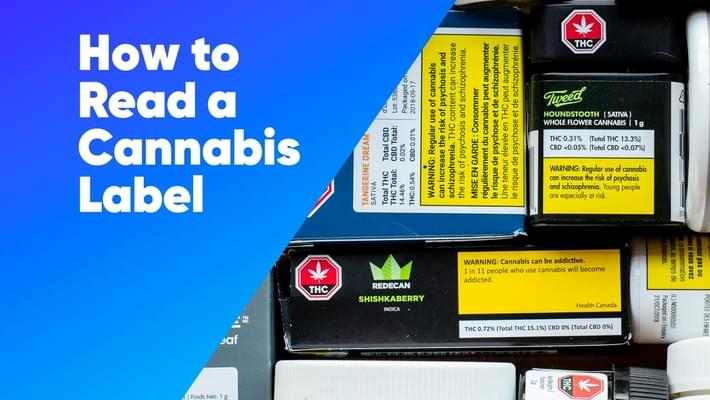
How to Read a Cannabis Label
Published on 1/6/23
While dispensaries today are filled to the brim with a beautiful variety of cannabis products, it can be hard to determine which will be the right fit for you. Even though they are affixed with recreational marijuana labels containing cannabinoid information, nutritional facts, and more, it can be challenging to see through the sea of terms and numbers to understand what they really mean. In this piece, we'll go through every element of how to read a cannabis label to understand what these products truly mean and how you can find the best combination of factors for you.
What is a Cannabis Label?
A cannabis label on recreational marijuana products, sometimes called dispensary labels, is an informative sticker that lists various information about the product it's affixed to. While regulations can vary state by state, each label has the same basic information, including cannabinoid content, weight, ingredients, etc. Cannabis labels give the consumer a swath of important information, including how much THC, CBD, and other cannabinoids are available for use.
Where Are They?
When trying to determine how to read edible labels or any other cannabis product label, it's helpful to know exactly where to look for your label. On most products, the label will either be affixed directly to the bottle or on the outer packaging (such as a cardboard box) that the product is inside when purchasing. It's essential not to throw away your cannabis packaging because you want to be able to refer to this information later on.
Why Do They Matter?
In legal cannabis dispensaries, all products require laboratory testing and must feature the results on their labels, similar to what you'd find on packaged foods at the grocery store.
Understanding these dispensary labels allows the customer to be an informed consumer, providing much more information than if their cannabis product is an indica, hybrid, or sativa alone. They can tell you if your cannabis product has been infected with mold or contains traces of residual pesticides.
Terms and Numbers
In different places around the world, there are different requirements for recreational marijuana labels. Here are a few examples of some of the most common terms and numbers featured on legal cannabis labels.

Net weight/volume
Dried cannabis is measured in grams, and this gram weight appears on the label. This is typically how cannabis is sold on the black market as well, where customers ask for as little as an eighth up to multiple ounces.
For edible products, the volume may be more applicable; such as a cannabis drink that contains a certain amount of THC (usually measured in milligrams) per container.
Total THC/CBD content
Total THC represents the total amount of THC that is available for use. This is typically one of the most important numbers for people wondering how to read a cannabis label. The total THC content will give the consumer a good idea of how affected they'll be on a psychoactive level. A "high THC percentage" typically has around 18 to 20+ percent total THC. These days, you can find products that go much higher, but novices will encourage you to use other factors, such as smell, to choose your strain.
For edibles, this number of THC is often measured in milligrams. Generally, the starting dose for an inexperienced cannabis user is 5mg of THC. Users should wait at least 2 hours before increasing their dose to ensure comfort. If you're a regular user, you may be more comfortable with about a 20mg dose.
Various Cannabinoids
While some companies will list the total THC content as one number, other dispensary labels list the amount of THCA and the THC available for use after its activation. These may also be written as THC Decarb. Together, THCA and THC percentages make up the total THC content/percentage.
Similarly, the CBD content or percentage listed on a label lists the amount of activated CBD present in the product. Totals of CBD and CBDA levels make up the total CBD content available.
While THC and CBD are some of the most prevalent cannabinoids, other cannabinoids like Delta 8-THC, THCV, CBN, CBG, and CBC may also be included in some capacity. Many of these cannabinoids have powerful mental and physical health benefits, so research some of their benefits to see if they fit your intention while smoking.
Terpenes are also considered cannabinoids, offering aromatic and flavor benefits and some emerging health benefits. When trying to determine how to read terpene percentage, look for your favorites and see what the dominant terpene profile is of your favorite strains.
What is TAC in Weed?
TAC stands for total active cannabinoids, the total amount of cannabinoids detected in the cannabis product. TAC shows the concentration and strength of the detectable cannabinoids present in a particular marijuana product. The TAC meaning in weed refers to a product's complete cannabis profile. Understanding TAC on dispensary labels will help both medical and recreational cannabis users to understand the potential effects of your products and consumption method better.
As for cannabinoids that are present but aren't detectable, they have to be either inactive or insufficient to have a noticeable effect. This means that the undetectable cannabinoids will not be a concern during consumption, considering they don't affect the product's potency. TAC cannabinoids indicate that they will affect the user's experience somehow.
Cannabis labels will also include some more self-explanatory items, like an ingredients list (this will be more relevant in edible products where there are additives besides purely THC) and instructions for use.
Edible products will also contain an expiration date and their nutritional content in terms of sodium, sugar, carbohydrates, and total fat.
